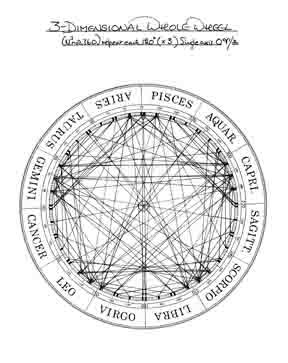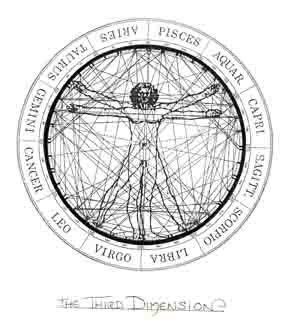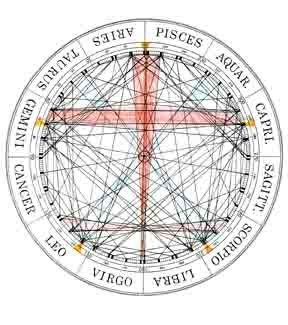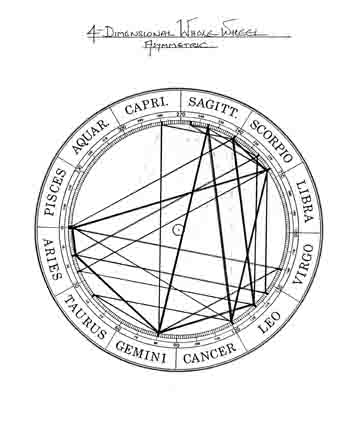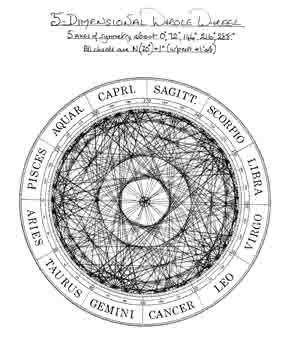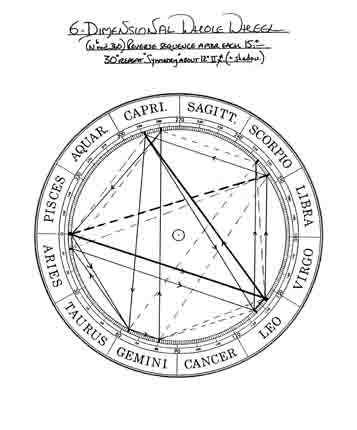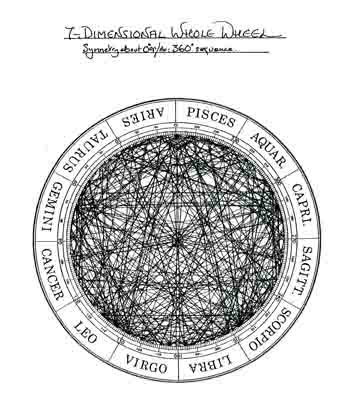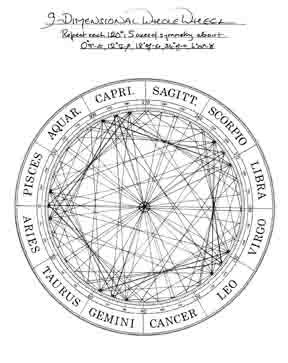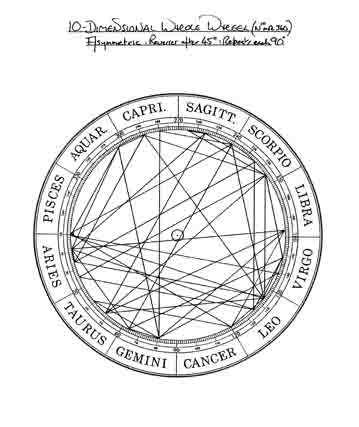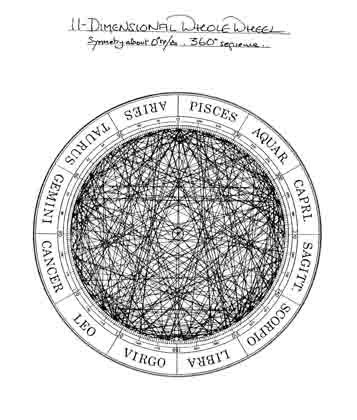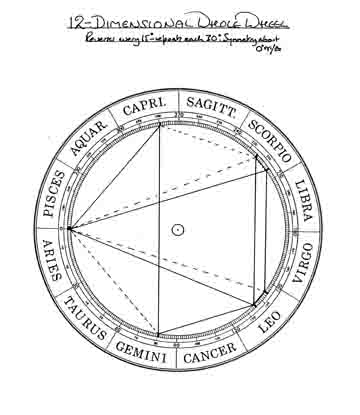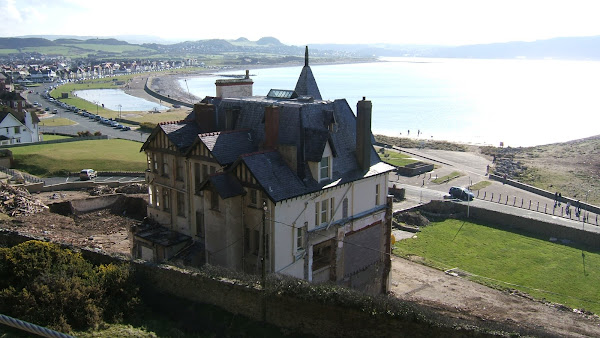In other words, I learned a bit more astrology this winter. I knew it was going to be tricky healthwise; I knew it was going to be unusually cold at least in North Wales, because of the culminating Sun/Pluto at the Winter Solstice coupled with Uranus/Saturn straddling the Llandudno horizon. But what I had quite overlooked was the importance of checking my relocated angles! Some of you may have been keeping an eye on these for years, and some may, like me, have not taken them too seriously as an ongoing sensitive area. What a mistake to make! There is no angle in any significant subsidiary chart that is immune to impact at least from transits. Happier has been Jupiter’s pootle over my progressed MC - a lovely bubble of energy came back, lasting several weeks, in which I was able to do some hugely useful new work on Chapter 19 of my book which Frank Clifford at Flare is re-issuing, revised and updated, later this year.
Just for the record, the Vernal Equinox also presented a chilly picture with Saturn at the IC and the Moon setting in Capricorn, and despite some very welcome Spring sunshine (it’s a glorious Easter Day as I write) it has indeed been distinctly parky here, with everything blooming and breeding at least a fortnight later than last year.
The attentions of the singing ringed planet have left several items for this page queuing up, unwritten. So I’d better crack on and offer them to you.
One is the interesting fact which others have also pointed out, that Pluto’s current foray into Capricorn is the first since 1762, a year right at the beginning of Britain’s - and subsequently the world’s - industrial revolution. By the time Pluto left Capricorn for Aquarius in 1778 most of the technology which would evolve and drive a new age of mass-production had been invented and had begun to impact on the lives of ordinary people. One of the earliest came in 1763 - John Harrison’s Chronometer, which went on ultimately to revolutionise time-keeping world-wide. Just look at the chart of that first ingress! Set for the English Capital, Uranus is right on the IC in Aries with Saturn, squared by Pluto with Mercury, all in a spectacular box of quintiles and a trine with Mars and the Moon. How could amazing new ideas about power and timing not take over the collective psyche under such a sky?

And now we have come full circle. At Pluto’s 2008 return the Scorpio South Node of that lastd epochal ingress is rising. The astonishing material potential of that moment has unfolded and accelerated over 246 years unmatched in human history to the point where we have the power to make or break our entire planet, to send ourselves collectively to heaven or to hell. Saturn stares sternly down at us from the Midheaven, trine Pluto, Venus and Jupiter in the 2nd house. We have the chance to re-evaluate everything that we have held so dear for over two centuries and to employ new and imaginative forms of social engineering to move forward technologically, humanely and spiritually without causing any further damage to our home. There is Mars quintile Saturn, and trining the stellium of N.Node, Mercury, Neptune in the 3rd. The dragon’s tail this time is in Leo in the 9th - we really must forsake our rampant self-interest and be loving to others; we must cherish every stranger as a member of our extended human family; we must each learn to see the Bluebird in the corners of our own home, on the corners of our own town, and stop chasing an elusive happiness all over this increasingly stressed planet.
We are melting our ice. Our friends in the mountains and plains would rather not burn. We who live at sea-level would rather not drown.
At 03h32 local time on April 6th L’Aquila and many surrounding villages and small towns in Italy’s central Abruzzi region were subjected to a half-minute earthquake that buried hundreds of people in their beds, made thousands homeless, and destroyed or damaged many historic buildings. The Moon was conjunct Ceres - there was much separation and grief. At the moment the quake struck, not only were the Nodes reflexing to the meridian, with S.Node to MC, but the dwad MC was with the radix S.Node.

It is terribly difficult to pin down any single clear set of configurations that trigger earthquakes. Many of us have been trying for years. Even if we succeeded, we might meet with the same verbal and legal assault as that poor fellow who logged the rising levels of Radon gas along the Abruzzi fault-lines and tried to warn the populace. He was accused of scaremongering, and taken to court. If you look at the combined radix/dwad chart for this earthquake (dwad at the centre) you will see that a very recent Mars/Saturn opposition in 16 Pisces/Virgo has been enhanced in the dwad by Saturn opposition Moon, and stressed to the limit by dwad Uranus. This whole pattern of mutable instability and strain is focussed on and square to the dwad Ascendant. Adding to the upheaval, the dwad also has Pluto right at the IC. Now, dwad positions repeat themselves quickly as faster planets change signs; but slower bodies like Uranus take at least six years to move from one sign to another, and the last time it was in the dwad position 17º26 Sagittarius was at radix 26º27 Aquarius in March and September 2002 and January 2003. So it could be worth watching for this kind of energy build-up between radix and dwad patterns in case their vibration resonates with the stress energies in vulnerable rock strata.
Literally bang on time, three enormous bolts of lightning hit the elegant stands at the spine of Malaysia’s Sepang circuit, the heavens opened, and a deluge of biblical proportions washed out the second half of last Sunday’s Formula One Grand Prix. 55 minutes earlier, cosy in our lounge, I had remarked to Gerard that (in view of the uncertain weather for the race) at 5h55 their time I expected a storm. What else? Uranus would be exactly setting. Well, the track forecasts kept coming in for rain any minute, and the cars kept coming in for wet tyres, then dry tyres, then wets again ... and still no rain fell. It was 10 minutes to the hour. Jenson Button, leading again from pole for the second race running, shot into the pits for dry tyres again. I groaned. ‘Give it a few minutes more, Jenson!’ He had hardly left the pit lane when the first rain-drops smeared the drivers’ visors; back he flew after just one lap and on went the deep-grooved wets. And then at 5 minutes to the hour - BANG!
To cut a slightly longer story short, this meant that as Jenson was leading the race at the end of the last complete lap, he was declared the winner, and for the second time this season we were treated to that glorious, infectious grin from ear to ear of a justly happy man who had at last been given a car worthy of his consummate skill. (Brawn GP was only set up on 6th March!) Now, I don’t have Jenson Button’s birth time - or indeed times for most Grand Prix drivers. But I have a Cunning Plan. I set up a Q chart - ie the driver’s chart for his (alas not usually her) birthplace but for the current race start time converted to the driver’s birth zone. Then I do a composite of the driver’s Q chart with the chart for the start of the race. The driver (Q), the race and the composite all go in a triwheel to see what’s going on.

It was a great racing weekend; the day before Sepang, Aintree saw a 100-1 virtual outsider, Mon Mome, win the Grand National after two false starts. I failed as usual to pick the winner; two purely emotional choices came in 3rd and 4th, but having bet nothing I lost nothing and gained nothing! Nevertheless I checked out a few things after the event and found that the trainer’s name asteroid, Williams, was right on the MC of the race chart of April 4th 2009 at 4h15 pm, and right opposite the Moon was Williams Bay - which described the horse! Now, what on earth was going on to provoke two false starts, before the race properly got going at 4h20 pm? I did a major double-take when I looked at the biwheel, though - because I’d seen it before.
 Where?
Where?Go back to the Italian earthquake. Look familiar? The identical pattern of strain is there, Uranus conjunct a mid-Sag. Ascendant in the dwad, squaring the radix - and at Aintree also the dwad - Mars/Saturn opposition. In the Aintree dwad chart for good measure the Moon and IC join that ‘rising’ Uranus. In both circumstances an insupportable degree of invisible stress had built up that had to be relieved by things held in check breaking free. At the Grand National racetrack the line of horses and riders broke away before their signal; at l’Aquila the rocks below the city could not keep still any longer and the fault-line broke.
I thought (as many may well have thought), ‘If an Earth-breath takes a year, and a human life lasts for a finite number of breaths, how old is the Earth? How long may she live? Is this a question that can be asked, or is it utterly ridiculous?’
So out came the calculator. I figured that if a person, resting, breathed in and out once every 5 seconds at a rough estimate, then in a lifetime of 84 years (one Uranus cycle seeming reasonable) - something over - breaths would have been taken. 12 a minute = 720 an hour = 17,280 a day = 6,307,200 a year = 529,804,800 in 84 years at our speculative earth-speed, so nearly 530 million years. Now, plants first appeared on land nearly 426 million years ago, and that would be the beginning of the carbon cycle as we know it. That, for argument’s sake, would now put Gaia the ecosystem at about 67½ years old, with an expectation of at least another 16½ of her ‘years’, or about 104 million of ours. But we all know how wrong things can go after middle age! We folk, for example, have been around - at various stages of our 1.8 million years of human evolution - for about 3½ months, making us look like a galloping parasitic infestation that is putting the health of Gaia at serious risk. There are only three outcomes - a) we will cause her premature death, and die with her, b) she will rid herself of us and slowly recover, c) we collectively mutate into a benign symbiont and we can all breathe again.






 Pluto had been squaring his Sun from the end of Sagittarius; but, remembering the Reflexes, it is still on that square, as his Reflex Sun is at Aries 1. I've put his radix chart in a triwheel with the Reflex and his Q-chart for the day he died - set for his home in Pacific Palisades, California. The angles of the Q-chart foretell a day of pain and separation - its IC picks up his natal Mars and on its Descendant is his Reflex rising Ceres. Transiting Chiron had reached his Ascendant, and the Sun was on his Reflex IC - the 'end of life'.
Pluto had been squaring his Sun from the end of Sagittarius; but, remembering the Reflexes, it is still on that square, as his Reflex Sun is at Aries 1. I've put his radix chart in a triwheel with the Reflex and his Q-chart for the day he died - set for his home in Pacific Palisades, California. The angles of the Q-chart foretell a day of pain and separation - its IC picks up his natal Mars and on its Descendant is his Reflex rising Ceres. Transiting Chiron had reached his Ascendant, and the Sun was on his Reflex IC - the 'end of life'.

 The Daily Progressed chart is quite astonishing - not so much in its radix as its Dwad, again: sudden separation from the body, family and friends is decreed by the great cross of Nodes and horizon with Sun and Uranus, and the almost precise conjunction of Ceres with the MC. I have never seen anything like it.
The Daily Progressed chart is quite astonishing - not so much in its radix as its Dwad, again: sudden separation from the body, family and friends is decreed by the great cross of Nodes and horizon with Sun and Uranus, and the almost precise conjunction of Ceres with the MC. I have never seen anything like it. Returning to Reflexes, lately I've been taking a look at their use with Solar Arcs. Arcs to Reflex charts deliver the same contacts as Reflex arcs to radix charts, so I go with the first option. Here's Patrick McGoohan's Reflex chart and his Solar Arcs to the day of death: again, fascinating! Here once more is Ceres centre stage, doubly reflexed with the Ascendant, while Chiron also makes twin contacts with the MC! Now, while Ceres grieves at separation, Chiron represents that immortal part of humankind that resurrects from death. We are looking at the soul's triumph over the body.
Returning to Reflexes, lately I've been taking a look at their use with Solar Arcs. Arcs to Reflex charts deliver the same contacts as Reflex arcs to radix charts, so I go with the first option. Here's Patrick McGoohan's Reflex chart and his Solar Arcs to the day of death: again, fascinating! Here once more is Ceres centre stage, doubly reflexed with the Ascendant, while Chiron also makes twin contacts with the MC! Now, while Ceres grieves at separation, Chiron represents that immortal part of humankind that resurrects from death. We are looking at the soul's triumph over the body.











 Annual progressions are the next stop - and the converses, because these, as usual, are showing stronger patterns at this tipping-point in each man's destiny. McCain's shows a nice feisty Moon/Venus/Mars conjunction on the Gemini Descendant - lots of publicity then, attracting the ladies, drawing the crowds ... but this is all moving back to the square with Saturn, and already his choice of running mate, his Moon/Venus/Mars/Desc Sarah Palin, has come in for a lot of negative attention and may have compromised his campaign. Barack Obama just has his annual sunset ... but it is stronger now; and the annual converse Ascendant is at 29 Sagittarius, right on transiting Pluto. Which has finished with McCain. Advantage Obama.
Annual progressions are the next stop - and the converses, because these, as usual, are showing stronger patterns at this tipping-point in each man's destiny. McCain's shows a nice feisty Moon/Venus/Mars conjunction on the Gemini Descendant - lots of publicity then, attracting the ladies, drawing the crowds ... but this is all moving back to the square with Saturn, and already his choice of running mate, his Moon/Venus/Mars/Desc Sarah Palin, has come in for a lot of negative attention and may have compromised his campaign. Barack Obama just has his annual sunset ... but it is stronger now; and the annual converse Ascendant is at 29 Sagittarius, right on transiting Pluto. Which has finished with McCain. Advantage Obama. I have set the Solar Returns for Washington DC, as I have no idea where each candidate spent his August birthday, and there is nowhere else more likely to throw up a useful pattern. Obama has Moon/Mars-Uranus straddling the horizon with Pluto at the IC, suggesting a very public and somewhat bumpy ride to the ballot box and beyond, with much power to his elbow. But will it be Presidential power? The Sun close to the approaching S.Node reminds us that the eclipse of August 1st fell conjunct his Sun, and this always presages significant steps along the path of the soul. McCain's Return has that S.Node rising, however, a position not to be envied as Self always has to come last, and planets nearby can signal the cause of one's undoing. Here, it's the Moon. This could be Sarah. Neptune sets with Chiron and the Dragon's Head, so he pursues his dream, but it could come to nothing if he has fibbed about his citizenship and skewed his birth details! (You need to follow the link from the bottom of his page at AstroDataBank to appreciate what I'm suggesting here.)
I have set the Solar Returns for Washington DC, as I have no idea where each candidate spent his August birthday, and there is nowhere else more likely to throw up a useful pattern. Obama has Moon/Mars-Uranus straddling the horizon with Pluto at the IC, suggesting a very public and somewhat bumpy ride to the ballot box and beyond, with much power to his elbow. But will it be Presidential power? The Sun close to the approaching S.Node reminds us that the eclipse of August 1st fell conjunct his Sun, and this always presages significant steps along the path of the soul. McCain's Return has that S.Node rising, however, a position not to be envied as Self always has to come last, and planets nearby can signal the cause of one's undoing. Here, it's the Moon. This could be Sarah. Neptune sets with Chiron and the Dragon's Head, so he pursues his dream, but it could come to nothing if he has fibbed about his citizenship and skewed his birth details! (You need to follow the link from the bottom of his page at AstroDataBank to appreciate what I'm suggesting here.) Obama, now, has his daily progressed Ascendant still close to the Sun, while the converse daily Descendant is right on Jupiter. That nice Venus of his is a whisker away from the DPMC - and transiting Pluto is opposite on the DPIC. What is more, the Sun/Mercury conjunction of Inauguration day is conjunct his Jupiter and the noonday Moon is shining on his natal MC. Most striking of all, when you put the two draconic charts together - Obama and the Inauguration - it is his Sun on the noon Midheaven, his Ascendant opposite the Sun/Mercury, his angular Moon on the 7th cusp. McCain is nowhere.
Obama, now, has his daily progressed Ascendant still close to the Sun, while the converse daily Descendant is right on Jupiter. That nice Venus of his is a whisker away from the DPMC - and transiting Pluto is opposite on the DPIC. What is more, the Sun/Mercury conjunction of Inauguration day is conjunct his Jupiter and the noonday Moon is shining on his natal MC. Most striking of all, when you put the two draconic charts together - Obama and the Inauguration - it is his Sun on the noon Midheaven, his Ascendant opposite the Sun/Mercury, his angular Moon on the 7th cusp. McCain is nowhere.




